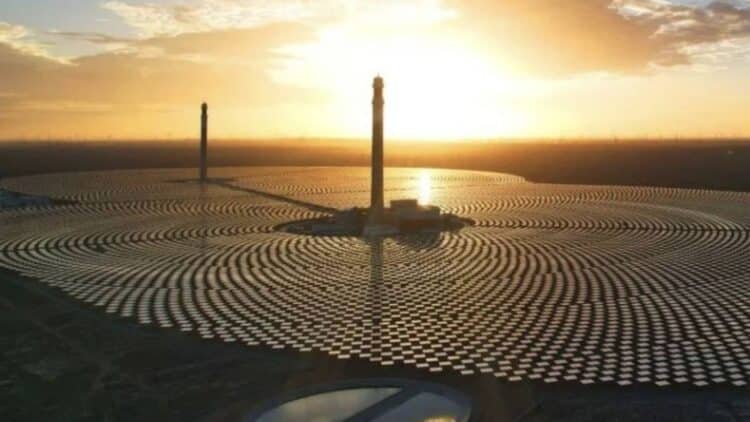Solar energy seems perfect; after all, the sun always shines to a greater or lesser extent. However, it has a major Achilles heel, which is its intermittency. When the sun goes down because it is nighttime or the sky is cloudy, electricity production drops to zero. To solve this, we rely on expensive and complex large-scale lithium batteries that store the energy we have collected throughout the day.
The Asian giant is perfecting a technology dedicated to generating solar energy 24 hours a day, seven days a week. We are talking about the new concentrated solar power plant from the Three Gorges Corporation. This energy project, located in the Gobi Desert, promises to overcome the biggest obstacle to solar energy. The solar plant does not use photovoltaic panels or chemical batteries, but rather 27,000 mirrors to generate uninterrupted electricity.
What is Solar Thermal Energy?
Most translators will be familiar with photovoltaic solar energy, which uses panels to directly convert light into electricity. However, there is also concentrated solar thermal energy, which works in a completely different way despite also using the sun’s rays. This energy should be thought of as a giant magnifying glass; its purpose is not to generate electricity immediately, but to concentrate heat. In the Gobi Desert, with thousands of high-precision movable mirrors, this power plant is able to follow the sun. The key is that these mirrors reflect all that light onto a single point: the receiver at the top of a central tower (and yes, it looks a lot like the Eye of Sauron, dear Lord of the Rings fans).
This central tower holds the great secret of nighttime power generation, as this concentrated light generates extreme heat that can reach up to 170 °C. This heat is transferred to a special fluid, which acts as a massive and efficient heat battery. This heat is stored for hours, including throughout the night when electricity is needed (whether at night or on a cloudy day), and is used to boil water, which creates steam and drives a traditional turbine.
The result is clean energy that can be released on demand, just like a gas or coal-fired power plant, but without emissions.
The Gobi Desert
Although the concept of solar thermal energy seems idyllic, it poses a real challenge in terms of efficiency and costs on a large scale. To solve this, China has decided to build this plant in the Gobi Desert, which receives more than 3,000 hours of sunshine per year. This desert is home to the world’s first “Dual-Tower Single-Machine” plant.
As we mentioned earlier, this plant is a radical concept. It uses 27,000 mirrors to concentrate light on two separate towers, each over 200 m high. Why not just one tower? The old design of solar thermal power plants with a single tower had a flaw, which was that optical attenuation reduced efficiency.
With two towers, there is an optimization of time: the system is designed so that the eastern tower receives the most solar radiation during the morning hours, while the western tower receives the most in the afternoon, treating the light at the most favorable angle. The mirror fields overlap slightly, ensuring constant and optimal energy concentration at all times. This makes the system 25% more efficient than traditional designs that used a single tower.
Being more efficient reduces the total number of mirrors needed to capture the same amount of energy, which in turn reduces construction and maintenance costs. It is an engineering solution that overcomes the major challenge of solar thermal scalability.
This twin-tower system is part of a much larger energy project, which also includes wind farms and solar farms. The combined capacity is designed to supply clean, stable energy to more than half a million homes per year. What is certain is that China is investing billions in optimizing solar energy, securing its position as a global leader.

